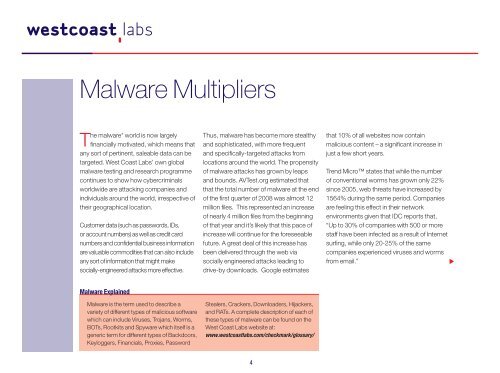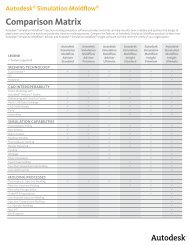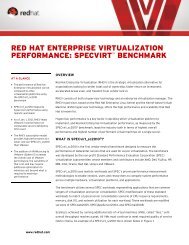The Changing Threat Landscape - Zift Solutions
The Changing Threat Landscape - Zift Solutions
The Changing Threat Landscape - Zift Solutions
You also want an ePaper? Increase the reach of your titles
YUMPU automatically turns print PDFs into web optimized ePapers that Google loves.
Malware Multipliers<br />
<strong>The</strong> malware* world is now largely<br />
financially motivated, which means that<br />
any sort of pertinent, saleable data can be<br />
targeted. West Coast Labs’ own global<br />
malware testing and research programme<br />
continues to show how cybercriminals<br />
worldwide are attacking companies and<br />
individuals around the world, irrespective of<br />
their geographical location.<br />
Customer data (such as passwords, IDs,<br />
or account numbers) as well as credit card<br />
numbers and confidential business information<br />
are valuable commodities that can also include<br />
any sort of information that might make<br />
socially-engineered attacks more effective.<br />
Thus, malware has become more stealthy<br />
and sophisticated, with more frequent<br />
and specifically-targeted attacks from<br />
locations around the world. <strong>The</strong> propensity<br />
of malware attacks has grown by leaps<br />
and bounds. AVTest.org estimated that<br />
that the total number of malware at the end<br />
of the first quarter of 2008 was almost 12<br />
million files. This represented an increase<br />
of nearly 4 million files from the beginning<br />
of that year and it’s likely that this pace of<br />
increase will continue for the foreseeable<br />
future. A great deal of this increase has<br />
been delivered through the web via<br />
socially engineered attacks leading to<br />
drive-by downloads. Google estimates<br />
that 10% of all websites now contain<br />
malicious content – a significant increase in<br />
just a few short years.<br />
Trend Micro states that while the number<br />
of conventional worms has grown only 22%<br />
since 2005, web threats have increased by<br />
1564% during the same period. Companies<br />
are feeling this effect in their network<br />
environments given that IDC reports that,<br />
“Up to 30% of companies with 500 or more<br />
staff have been infected as a result of Internet<br />
surfing, while only 20-25% of the same<br />
companies experienced viruses and worms<br />
from email.”<br />
s<br />
Malware Explained<br />
Malware is the term used to describe a<br />
variety of different types of malicious software<br />
which can include Viruses, Trojans, Worms,<br />
BOTs, Rootkits and Spyware which itself is a<br />
generic term for different types of Backdoors,<br />
Keyloggers, Financials, Proxies, Password<br />
Stealers, Crackers, Downloaders, Hijackers,<br />
and RATs. A complete description of each of<br />
these types of malware can be found on the<br />
West Coast Labs website at:<br />
www.westcoastlabs.com/checkmark/glossary/<br />
4















